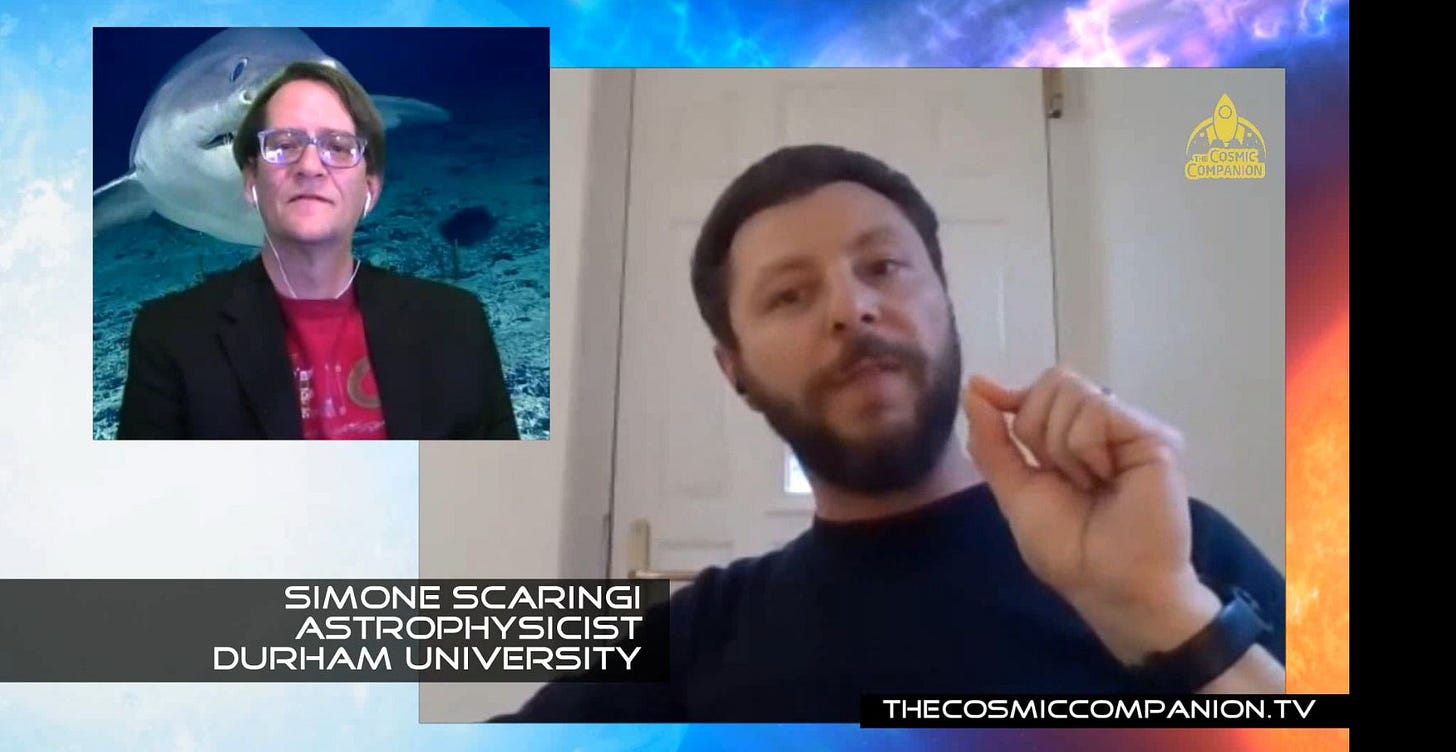There may be more than 100,000,000,000,000,000 stars in the Universe, each of which is born, lives and dies. We look at these magnificent fusion reactors made of nothing but gas, talking with Simone Scaringi, astrophysicist at Durham University.
Hello all:
Welcome back to The Cosmic Companion!
This week, we look in on the lives and deaths of stars with Simone Scaringi, astrophysicist at Durham University
When we look up at the moonless, cloudless night sky, far away from city lights, we may see as many as 5,000 stars. These distant dots of light may seem eternal, but this illusion is merely an effect of our momentary, fleeting lives in the Cosmos.
Like humans, stars are born, live, and die. Most stars are found within local families called galaxies. Our own Milky Way is thought to contain somewhere around 400 billion stars. And there may be a trillion galaxies spread throughout the Cosmos.
Stars form within massive clouds of gas and dust similar to the stellar nursery we recognize as The Orion Nebula. The Mayan civilization believed this fuzzy patch of light in the sky was the embodiment of the fires of creation. For star systems being born here, they were right on the mark.
Full transcript continues below for VIP subscribers!
Next week: Science Fiction to Science Fact with Jenny Curtis and Chris Potter from the hit sci-fi podcast, Solar, starring Helen Hunt. Join us on 31 May for this exciting episode!
Clear skies!
James
VIP Extra: Full Transcript (cont.)
As stars coalesce, increasing mass results in an enormous gravitational field, pulling the nascent star inward, toward a gravitational collapse.
Temperatures and pressures at the core of stars is great enough to not just shatter atoms, but to combine protons and neutrons of hydrogen, forming other isotopes of hydrogen, together with helium and energy. This fusion pushes outward from the center of the star. For most of the lifespan of a star, the body remains poised in a balance between this outward pressure and gravity, attempting to pull the star inward.
Unlike our solitary Sun, most stars are found within multiple star systems — binaries, trinaries, or morenaries (OK, I just made that last word up).
In some binary systems, one star will lose material to a smaller white dwarf (a stellar corpse), which will spiral in, enveloping the recipient star in material from its partner. If enough of this gas builds up, temperatures rise, and when the first region reaches 10 million Kelvin, it will trigger thermonuclear reactions. This raises temperatures in surrounding regions of the gaseous encasement, resulting in a chain reaction, creating a classical nova — an eruption over the surface of the white dwarf. Afterward, the star is left more-or-less unscathed, and this process can repeat.
In some close binary systems, however, this eruption takes place within the bodies of white dwarfs. These outbursts result in the destruction of the smaller member — an event called a Type 1a supernova. The power released by these explosions is fairly consistent, allowing astronomers to use Type 1a supernovae as a “standard candle,” with which to measure the distance to far-flung galaxies.
A previously unknown type of nova, dubbed a micronova, has recently been found by a team of researchers led by Dr. Simone Scaringi of Durham University. We talk with Simone Scaringi about this explosive new discovery.
Our Sun fuses around 620 million metric tons of hydrogen each second, turning around 4.25 million metric tons of matter into electromagnetic radiation. In the 4.5 billion years the Sun has lit up the sky, our parent star has converted roughly one Saturn worth of hydrogen gas into energy!
Naturally, this can only continue for as long as stars retain enough fuel. When that fuel runs out, gravity begins to draw the body inward once more, portending its death. How that process unfolds depends, entirely, on the mass of the star.
Our own Sun, a relatively small star, has been shining for around 4.5 billion years. As time goes on, the surface of the maturing star heats up. Within a billion years, temperatures on Earth will have grown so hot that all the oceans will boil away, followed by a period where the surface of our planet will be a parched, scorched landscape, even hotter than Arizona in late June!
Roughly 4.5 billion years from now, the Sun will run out of available hydrogen, and gravity will pull our venerable star inward, igniting helium fusion at its core. This ignition will force the Sun to increase in size once more forming a red giant, swallowing the planets Mercury and Venus, and (most likely) the lifeless remains of Earth. Over time, helium fuel will run out, and the Sun will shrink once again, into a white dwarf, roughly the size of a typical city.
Stars more than eight times as massive as the Sun, however, are able to fuse helium into carbon. These stars too, meet a final collapse, and can erupt in a Type 2 supernova — the titanic explosion of a massive star.
These eruptions can leave behind a neutron star, the size of a typical city. Just one teaspoon of this ultradense material would weigh more than Mount Everest.
The ultimate fate can await stars that begin with 30 times as much mass as the Sun. The most massive stars in the cosmos can, sometimes, end their lives as black holes — the most mysterious objects in the Universe!
Visit us next week on the Cosmic Companion as we look at How Science Fiction Inspires Science Fact. We will talk with Jenny Curtis and Chris Porter from Solar, the new hit science fiction podcast starring Helen Hunt. Make sure to join us starting on Tuesday, 31 May.
Clear skies!
Thanks for being a VIP subscriber!
James




Share this post